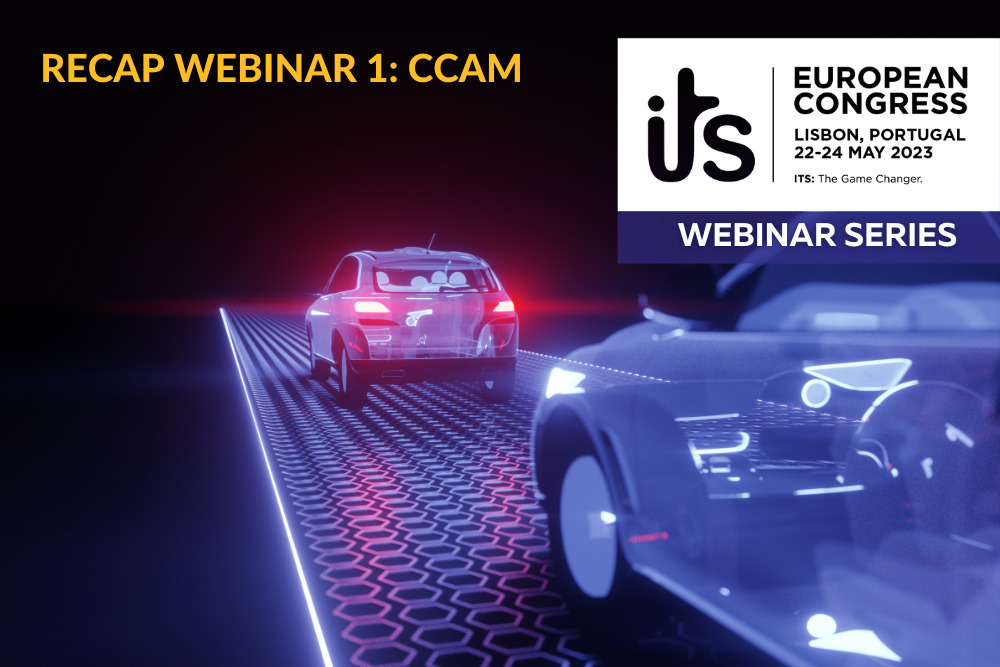Cooperative, Connected and Automated Mobility (CCAM) is a major theme at this year’s ITS European Congress in Lisbon, 22-24 May. In the first of a new webinar series, an expert panel was brought together by ERTICO – ITS Europe to discuss CCAM topics, including physical and digital infrastructure (PDI), pilots and testing, the need for standards, and policymaking.
“The theme for the Congress is ‘ITS: The Game Changer’ and CCAM is at the heart of that change, making mobility smarter, cleaner, safer and more sustainable,” says Joost Vantomme, CEO of ERTICO-ITS Europe. “Our organisation is unique in ITS as we connect the dots, bringing the public and private sector together to drive innovation.” This is evidenced, he says, by the numerous partners, projects and platforms – including CCAM – that involve ERTICO-ITS Europe.
Ramping up CCAM activities in Europe
The European Commission sees CCAM as an important contributor to “big picture” activities such as the European Green Deal (providing sustainable alternative solutions), European Data Strategy (common European mobility data space), Sustainable & Smart Mobility Strategy (automated mobility deployed at large-scale by 2030), and EU Missions to deliver at least 100 climate neutral and smart European cities by 2030.
“CCAM is going to make our roads safer, contribute to diminishing the impact of road transport on climate issues, and allow for transport services to be extended to people that today do not have easy access to them,” says Andrea de Candido, Future Urban and Mobility Systems Policy Officer, European Commission, DG RTD. He references the creation of the co-programmed innovation-led CCAM Partnership in 2021 as an important step towards achieving these and other goals. With 207 members and a one billion euro budget, its first projects kicked off in 2022. In July 2022, meanwhile, the EU General Safety Regulation was adopted: the first regulation in the world to explicitly foresee Level 4 automation on the roads.
The three phases of CCAM implementation as described by Andrea – developing the building blocks, followed by advancing technical maturity, then trials and living labs across Europe – neatly reflect the ERTICO-ITS approach. “International co-operation for CCAM is another priority for the Commission,” he adds. “The market will be global.”
A roadmap for CCAM
As a founder member of the CCAM Partnership and through collaborative projects such as FAME (Framework for coordination of Automated Mobility in Europe), SINFONICA (inclusivity, accessibility and equity in CCAM), PoDIUM (26 partners working on a reference architecture for PDI), and SUNRISE (harmonised European Safety Assurance Framework), ERTICO is at the forefront of making CCAM a reality.
The ERTICO’s roadmap aims for operational CCAM services that are integrated, accepted, inclusive and infrastructure supported by 2035, actively supporting decarbonisation. With various steps required to get there, co-ordinated tools and harmonised approaches are essential, says Dr Stephane Dreher, Senior Manager I&D, ERTICO-ITS Europe.
“We’ve been involved in Commission funded projects such as ARCADE, HEADSTART and ENSEMBLE to build harmonised approaches, and these have been followed by projects like FAME, co-ordinated by ERTICO, to build a framework for testing.” Stephane says it’s also increasingly important to ensure a deeper understanding of user acceptance and the wider social and end-user impacts of CCAM: through the WE-TRANSFORM project, for example, and the many large-scale demonstrations taking place in Europe.
CCAM and the future of urban mobility
Urban settings are an important focus for CCAM. “We see the future of urban mobility as cities without congestion, with people walking and riding, more nature-based solutions, and public services working smoothly, ideally with electric vehicles or vehicles that are connected and not making many emissions,” says Ricardo Vitorino, Head of Research & Innovation for Smart Cities at Portuguese R&D software company Ubiwhere. He points to co-operative transport systems and automated driving as critical ways to improve safety, cut fuel consumption and emissions, and reduce time wasted due to traffic – “always thinking with the citizen at the centre of the approach.”
You can see Ubiwhere, its Urban Platform solution and learn about its modular mix-and-match approach for “shared smart infrastructure” at the ITS European Congress in Lisbon.
With mobility mega-trends including rising populations in urban areas and an ageing population, last-mile electric autonomous shuttles are emerging as a useful solution – described as “CCAM pioneers in urban mobility” by Francisco Sánchez Pons, Director of Electronics, ITS & Smart Mobility at CTAG, Galicia’s automotive technology centre. “We have developed our own concept of the Cooperative Connected Autonomous Shuttle. One of its main aspects is an onboard communications unit: connectivity is a key element for CCAM, particularly when you’re looking at increasing levels of automation and complex scenarios.” Importantly, the shuttle is part of a holistic, connected ecosystem that includes smart traffic lights, sensors across the city’s infrastructure, intelligent, cooperative shuttle stations, and a traffic management centre.
“This approach means you can implement many different CCAM use cases and prove the behaviour of autonomous vehicles in terms of safety and efficiency,” Francisco says, “such as cooperative VRU (vulnerable road user) detection and cooperative intersections.” CTAG shuttles will be demonstrated at the ITS European Congress in May.
‘Inventing tomorrow’s driving’
Working towards a CCAM-enabled future, ERTICO is also collaborating with the European Space Agency (ESA) and its Open Space Innovation Platform (OSIP) to advance the use of ubiquitous PNT (Positioning, Navigation and Timing) for CCAM. ACall for Proposals to submit ideas has been issued under the ESA’s Navigation Innovation and Support Program (NAVISP), which closes on 28 February 2023. You can find more details here.
Lisbon: exploring the future of shared mobility
“It’s the ideal host city,” says Lisa Boch-Andersen, Director of Communications, Congresses & Events, ERTICO-ITS Europe. “It’s a multi-modality city in action.” The CCL congress centre will welcome more than 3,200 international ITS experts. Alongside and linked to CCAM, the other focus areas are New Mobility Services, Freight & Logistics, Digitalisation & The Data Value Chain, and Future Traffic Management. Lisa adds, “The ITS European Congress is a unique setting to meet and network with colleagues, get involved in policy debates, see innovative technology in action, and a great opportunity to establish new business partnerships. We hope to see you there!”
You can watch the webinar on-demand here.
Registrations open mid-February, make sure to grab the early bird rates before 17 April 2023.
Please visit www.itseuropeancongress.com for more details, including partnering and sponsorship opportunities.
The post Getting CCAM on the road: Future Mobility is co-operative, connected & automated appeared first on itseuropeancongress.com.

